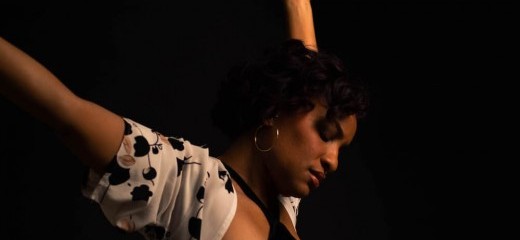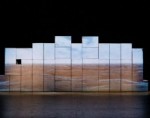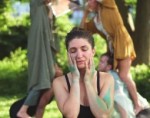
Taking the Ride: An Interview with Dawn Marie Bazemore
by Amelia Rose Estrada
Dawn Marie Bazemore is a choreographer, assistant professor of dance at Rowan University, and founder of Dawn Marie Bazemore|#dbdanceproject. This month #dbdanceproject will present Letters and The Browder Project at the Performance Garage on April 19 and 20. We sat down to speak about her work and her experience as the Dance Visions Artist in Residence at the Performance Garage. After the show on April 19, Bazemore will host a post-performance chat with Kalief Browder’s brother and proceeds from the merchandise sold at the production with be donated to the Kalief Browder Foundation. Her choreography is also being presented this month by Philadanco at the Kimmel Center April 12-14 and by Nimbus Dance Works at BAM April 26-28.
Amelia Estrada: Can you share a little about your performance career?
Dawn Marie Bazemore: I danced with Philadanco right out of college for ten years. I did the first national tour of The Color Purple and some regional shows around the country. I was interested in musical theater before I was interested in dance. As a little kid watching West Side Story I was like, “that is amazing. I want to do that!” I sang in church, had vocal training, and because I liked theater, I of course was taking dance. Dance just kind of stuck with me. It was the most consistent part of my life and so it seemed like the natural path through high school, college, and my professional career, but I always knew I would come back to musical theater at some point.
AE: How did you decide to return to school for your MFA? Is that where you decided to shift your focus to choreography and teaching?
DMB: I did not make a strong decision to transition into any of that. I got married and had a baby and I needed more stability in my career. I loved teaching, but I did not want to teach children. When I was touring with Philadanco, we taught a lot of master classes and they tended to be at universities. I was always attracted to teaching students at that level because they are adults who are curious and strongly considering dance as a career.
Choreography came later. In grad school I had to choreograph—part of my thesis was presenting [choreography]. I was at Virginia Commonwealth University doing my first residency after grad school and that is when Joan Myers Brown asked me to choreograph on Philadanco’s first company. I thought she was joking. I was like “really?” and that is how that happened.
AE: How do you choose what you want to choreograph about? Could you share about your creation process?
DMB: My connection to each work that I have made is deeply personal. I am a mother. I have two boys and a girl. Up until this new work, my work has been specifically about black men in this country, because I am raising two black men, and that is how I connect to these stories. When I created A Movement for Five, about The Central Park Five, I was watching the documentary by Ken Burns called The Central Park Five with my eldest son. I grew up in New York when that was happening in real time, and also watching my son watch that … understanding who he is in this country in relationship to his peers, who are not black, was an interesting experience for me.
Again, years later, talking with my son about prison, and about his misunderstanding of how men are treated in prison, and that somehow, they are protected because there are guards in prison, when actually it is the opposite. I had come across Kalief Browder’s story, and I was like, “well the videos are here, they are on YouTube,” of Kalief being abused in prison. We watched those together and we had those conversations.
With my younger son that year, for Christmas, I was looking for books that were about slavery that were appropriate for toddlers. I found one about Henry “Box” Brown and I was moved to tears by the images. The story is about a man who was a slave who shipped himself to freedom in a box, on a boat. There are these beautiful images of him in the box in different positions. I think I had read that first, and I remember thinking it would be interesting to do that in theater. Kalief Browder had spent 98% of his time in prison in solitary confinement, and they call that "box days," so it was connecting those two ideas.
AE: What has your experience been like as the Dance Visions Resident?
DMB: We are here. Thank you, Dance Visions. The biggest takeaway for us, and by us I mean the company, is that we have become a company. They would laugh at me, but I say this all the time, “I don’t have a company. This is just me and my friends dancing, playing around, for a little bit of money.” We have definitely gelled in the way a company does, which is really beautiful … it feels familial. You can see how everyone dances so well together now and understands each other.
During this process I did a lot of grant writing. I had so much support, many proofreaders, and lots of suggestions on how to make the writing stronger. It is hard to make dance make sense on paper because many funders are not artists. So you have to be able to write in a way that they can envision what you are saying. Jeanne [Jeanne Ruddy, founder of the Performance Garage] has been my choreographic mentor for the residency and also has been really specific about wanting me to walk away from this with my own supporters, which has been great.
AE: What are you presenting for this residency?
DMB: The piece I created is called Letters. I came up with the idea over the summer at Jacob’s Pillow, where I was a choreography fellow. Each section is based off a letter I wrote to someone I wish I could speak to. These are not letters I wrote and put in the mail, it was more therapeutic. Some of them are political, I wrote this letter that came out of conversations with two of the dancers about religion and if we could talk to God what would we ask Him.
And then I initially wrote a letter to the president. As we built the section, I realized, this is not about the president, it is about the community and how we are responding to the president. There is a section about sexual assault and it is personal because it is about my experience with it. Some of the letters are verbal and in the score. I wrote a letter to my fathers. I am adopted but I don’t have a relationship with my adopted father or my biological father so there is a lot I had to work through there. The first letter I wrote at the Pillow was to Trayvon Martin’s parents and that section is a duet. It seems political, but it is more about family.
Last year when we presented Browder we had a post-performance chat and it was really productive. Someone in the audience was like, “this is really great, but what else can we do besides dance about it?” That really stuck with me. So this year I stalked Kalief’s brother, Akeem; I filled out the contact form for the Kalief Browder Foundation and he emailed me back directly. He will be here opening night. We are going to do a post [performance] chat that is only about Browder with me and Akeem. I only know what I read and my research, but it is his family.
AE: What is next for you and #dbdanceproject? Are there any final thoughts you would like to add?
DMB: We should have another season. We should do this every year and the Performance Garage should be our home. I also love being commissioned to choreograph. I am working hard to establish #dbdanceproject as a company.
I feel really blessed to be surrounded by a team of people who really believe in the work. It is not just me making up steps, it is a collaboration and I could not be more grateful. I could not do it without all of them … taking the ride with me.
By Amelia Rose Estrada
April 13, 2019










